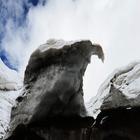Purog Kangri Glacier, There are not only glaciers in the Arctic.
Nagqu Shuanghu County, Tibet Autonomous Region
2.8
Introduction

Address Nagqu Shuanghu County, Tibet Autonomous Region

